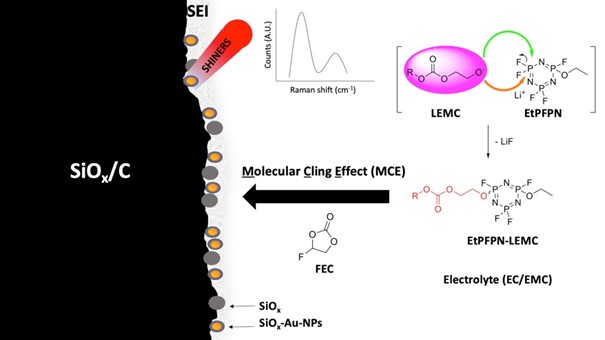New Perspectives for SEI Forming Additive Compounds
Functional additives are an effective way to develop customized electrolytes for lithium-ion batteries (LIBs). For example, they can be used to form solid interphases between the electrolyte and the electrodes without decomposing the electrolyte during this process. Fluorinated cyclic phosphazene compounds in combination with fluoroethylene carbonate (FEC) are considered promising electrolyte additives which can decompose to form an effective, dense and thin protective layer on the surface of the electrodes. In a joint study by MEET Battery Research Center at the University of Münster and Helmholtz Institute Münster of Forschungszentrum Jülich, scientists have now investigated how the two additives interact constructively during battery operation and how they influence the formation of the solid electrolyte interphase (SEI).

Novel Characterized Property of FEC Enhances SEI Formation
The research team analyzed the two additives FEC and ethoxy(pentafluoro)cyclotriphosphazene (EtPFPN) in an aprotic organic electrolyte in LIB full cells. “We investigated the influence of the dual-additive approach on the formation of the SEI and the interaction of electrolyte constituents to inhibit side reactions,” explains MEET scientist Adjmal Ghaur. Using in situ measurements, the team characterized a novel property of FEC, called the molecular-cling-effect (MCE). This allows the additive compound to cling effectively on the anode surface and thus participate in SEI formation without negative effects on the bulk solvent and electrochemical performance of the battery cell. “Currently, there is almost no comparable enhancing effect for FEC mentioned in literature. SEI formation in LIB cells is improved and new perspectives for SEI additive compounds are opened,” Ghaur classifies. These approaches need to be further explored now.
Entire Study Open Access
The entire study has been published by the scientists Adjmal Ghaur, Christoph Peschel, Iris Dienwiebel, Leilei Du, Laurin Profanter, Dr Sascha Nowak and Dr Tobias Placke, MEET Battery Research Center, Felix Pfeiffer, Dr Diddo Diddens, Matthias Weiling and Dr Masoud Baghernejad, Helmholtz Institute Münster, as well as Prof. Dr Martin Winter, MEET Battery Research Center and Helmholtz Institute Münster, in the magazine “Small”. The research includes results from the research projects “Green Electrochemical Energy Storage” (GrEEn) and “Electrolyte Formulations for Lithium Batteries” (EFoBatt).

